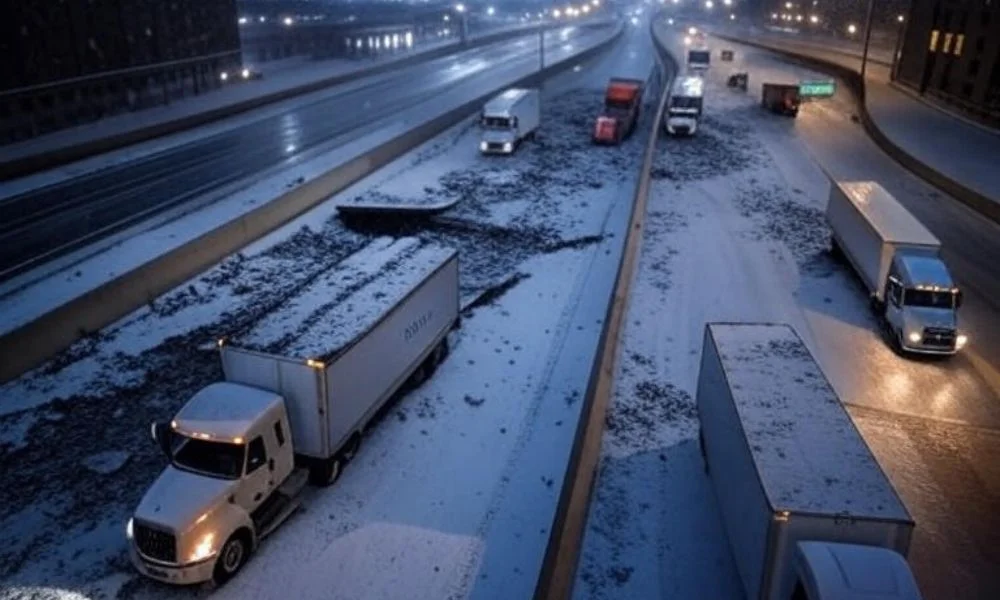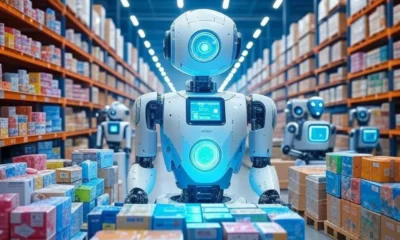Artificial Intelligence
Why Weather Forecasting with AI Is Changing Route Planning
Discover how I use AI weather forecasting to plan smarter delivery routes and avoid costly delays. Learn how real-time tools improve logistics, cut fuel use, and keep shipments on time.

One snow storm at Chicago last winter closed the highways and stranded hundreds of delivery trucks overnight. damage caused in that disaster resulted in slower deliveries, spoilt of perishable items and millions of dollars lost by the logistic services in additional costs of fuel and products. I know those problems first-hand, and I know that old route tools simply can not respond quickly with the weather starts going south.
Definition:
AI weather forecasting uses I use AI to avoid delays and cut fuel costs. Discover smart tools that keep deliveries on track in any weather. to predict upcoming weather conditions and optimize delivery routes in real time.
I started using predictive weather analytics to make smarter delivery route planning decisions, and it completely changed how I operate.
Today, I do not wait in queues, I secure good transportation, and save gas by acting on timely AI forecasts, which ensure that my trucks safely run. At Antion, we are using AI tools to gain an advantage over extreme weather events and improve logistics reliability as well. In this blog, I will demonstrate to you how exactly I use AI tools.
Learning the AI Powered Weather:
AI weather forecasting uses machine learning to analyze massive weather datasets and create real-time predictions for delivery routes.
I trust in it since it does not simply follow up on the clouds or temperatures but it learns patterns and gets better each time it analyses new information. As compared to the conventional predictions, the tools incorporate the block-by-block and minute-by-minute alterations in weather thus, enabling me to plan smarterly.
So, how does AI actually make weather predictions for delivery route planning? forecasting of what is coming ahead in AI models is done with more precision by means of satellite feeds, radar scans, traffic sensors, and history of weather patterns. It implies that I will be able to receive warnings about road blockades, affected icy roads, or flash floods even before my drivers get out of the warehouse.
More sophisticated systems may have the ability to automatically alter delivery suggestions based on the neural networks and real-time data fusion. Such AI tools are always updating the forecasts and the road directions even when a delivery is already on the way using the changing weather.
Way Weather Affects Delivery Processes:
Trucks can be affected by rainstorms, snow or even fog which slows them down and makes them lack visibility hence, posing great safety implication on my delivery drivers. These are the delays, broken packages or enforced rerouting brought about by even slight changes in weather conditions, which throws my whole schedule off its track. In the past, when I used to refer to simple forecasts, I was unable to make a conclusive decision to prevent such expensive protests.
What are the insidious factors of weather impact on the performance of delivery?
Storms may cause interruption in supply chains by blocking roads, changing the route of the highways, and delaying the supply of warehouse loading. Misbooked appointments and broken deliveries can lose a customer, but what will also happen is it will raise my overtime expenses and waste my fuel allocation.
Why should this be of concern to the cost of logistics in the U.S?
Disturbance experienced by weather activities enhances insurance claims, use of fuel and wears out vehicles. AI weather forecasting helps me stay ahead of these risks, giving my business a real competitive edge in tough conditions.
Benefits of AI Weather Forecasting in Route Planning:
Why should I rely on AI weather forecasting instead of traditional delivery planning tools? Since AI provides a clear way out even before mayhem begins, it forecasts changes in weather conditions and reorchestrates shipments on demand. It also implies that I will not be wagging in traffic, wasting time, and having my staff and goods in motion even at unplanned situations.
What is its contribution towards savings in fuel and time?
Delivery planning AI helps reduce the kilometers unnecessary and limits the fuel burning by calculating the optimal routes using weather data and traffic. I save hours every week and lower fuel expenses on my entire fleet by avoiding such roads as flooded streets or icy highways.
What is the importance of customer satisfaction?
Accurate weather based ETAs improve trust and reliability, especially when customers depend on timely and damage-free deliveries. Delays are inevitable, but when they occur, AI assists me in responding quicker and smarter to rerouting, as well as sustaining the quality of service even during bad weather.
Artificial Intelligence assisted Real Time decision making:
How will I manage the delivery routes in the event that the weather changes during the middle of the route? I am using AI tools where my drivers can be updated in real time with new directions in case of storms, blockage, or delays.
What type of tools can assist me in quick reaction in case of deliveries?
My drivers are directed by smart applications that notify them of weather forecasts, and the global positioning requirement alongside gadget pointers using artificial intelligence.
Do you mind an example in life?
My AI route planner has in the past saved my fleet when flooding affected a section of Florida. Immediately it would redirect my fleet to avoid flooded roads. When others had to deal with delays and cancellation, I was on time and preserved the safety of people and packages in my trucks.
Incorporation of weather forecasting in the delivery systems:
How do I bring AI weather forecasting into my existing delivery setup? I begin with weather APIs and route planning software, which is integrating simply with my transportation manager systems. They have platforms with real time forecasts using logistic planning, such as Tomorrow.io, IBM Weather Company, or OpenWeatherMap.
Which technological stack is most suitable to me?
I integrate GPS Monitors, Routing Solutions using AI and Live Weather Information to have an interconnected responsive delivery network.
This implies that all the decisions that are made concerning the dispatching, rerouting, and changes in ETAs are made smarter thanks to smart weather forecasts and traffic insight.
What is the relationship between it all?
My systems retrieve data through satellites, IoT sensors, and historical records of delivery to point out current planning decisions. It all works relatively well in the background so that I can concentrate on man-management and performance as opposed to studying the weather.
There are challenges and considerations:
Is AI weather forecasting always accurate? On the one hand, it is much more accurate than a simple forecast, on the other hand, no model is going to be 100 percent accurate, at least in weather that is changing rapidly. I have learned to be optimistic with the trends but keep backup plans in case the conditions change without prior warning.
What is the boundary of weather information and provision?
On occasion the data feed is delayed or the sensors are late in recognizing real time changes that may temporarily confuse the routing. That is why I employ the tools that combine the data sources to eliminate delays and increase reliability in poor weather.
Is AI route forecasting affordable to every business?
The initial expenditure in installation and equipment may appear to be prohibitive, particularly when the logistics staff is small or the delivery firms are local. Cost of investment, however, pays off in the long-run in saved fuel, time, and delay prevention in my experience.
AI and Weather Aware Logistics: Trends and Future:
What is making weather prediction with AI even smarter when it comes to making deliveries? Forecasting has become hyperlocal and I can now have street-level weather risks in real-time on the move when making urban deliveries. I apply it to make more intelligent last-mile choices to minimize the delays and secure high value or time-sensitive shipments.
Which are the emerging technologies changing weather based delivery planning?
AI is collaborating with IoT smart sensors on my cars sends a report on road conditions and temperature changes in real-time. This is in-time feedback loop that assists in automatic correction of routes and which makes me feel good in high weather zones or in weather zones that are unpredictable.
What next is in store in U.S. logistics?
Autonomous vehicles and drone deliveries will rely heavily on AI weather forecasting to make safe, legal, and fast decisions. With what I envision in the future delivery systems, I hope that route adjustments will be an automated process where pressure will be removed on the dispatchers leading to a greater level of efficiency.
Conclusion:
AI weather forecasting has completely changed the way I plan and manage delivery routes across my logistics network. I no longer hurt my business by delaying the delivery process at an expensive rate and wasting too much fuel, all this is because I am able to retain satisfied customers even when weather conditions turn unpredictable or even extreme. By trusting real time insights and predictive weather analytics, I’ve made my operations more reliable, efficient, and cost effective.
Whether you work in logistics or you manage a delivery service, it is high time to turn to the possibility of AI tools to safeguard your fleet and your profit. Weather was a thing that will always be present, but thanks to AI it is no longer a disruption anymore. Smart planning of the routes begins with smart data, and I personally witnessed how much of a difference it makes.
-

 Artificial Intelligence8 months ago
Artificial Intelligence8 months agoWhat is Artificial Intelligence? A Comprehensive Guide for Businesses and Enthusiasts
-

 Artificial Intelligence6 months ago
Artificial Intelligence6 months agoHow to Use Grok AI: A Complete Guide
-

 Artificial Intelligence8 months ago
Artificial Intelligence8 months agoUnlocking the Power of Artificial Intelligence Tools
-

 Artificial Intelligence7 months ago
Artificial Intelligence7 months agoWhat is DeepSeek? Revolutionizing AI with Cutting-Edge Solutions
-

 Artificial Intelligence3 months ago
Artificial Intelligence3 months agoAI Technologies in Warehouse Automation:
-

 Artificial Intelligence4 months ago
Artificial Intelligence4 months agoMeta’s AI Push: The Standalone Assistant App Set to Rival ChatGPT
-

 Artificial Intelligence3 months ago
Artificial Intelligence3 months agoHow Artificial Intelligence is Revolutionizing Logistics:
-

 Artificial Intelligence3 months ago
Artificial Intelligence3 months agoPredictive Analytics for Demand Forecasting:


